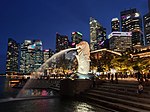Esplanade Bridge

The Esplanade Bridge is a 261-metre-long (850 ft.) road bridge that spans across the mouth of the Singapore River in Singapore with the Esplanade - Theatres on the Bay on its northern abutment and the Merlion on the southern. The 70 metre-wide (230 ft.) low-level concrete arched bridge has seven spans and supports two four-lane carriageways and walkways along both sides.The bridge was built to provide faster vehicular access between Marina Centre and the financial district of Shenton Way and to displace traffic from St Andrew's Road and Connaught Drive. Construction of the bridge began in early 1994 and was completed in March 1997. Service 501 is the first bus route to pass by the Esplanade Bridge. On 10 July 1999, the right turn from Hill Street to Bras Basah Road is prohibited, and motorists had to use High Street and Parliament Place, together with the St Andrew's Road. The main contractor was Obayashi Corporation while the street lamps were designed by Light Cibles. The bridge then blocked views of the Merlion statue from the Marina Bay waterfront, raising a need for the original Merlion statue to be relocated from the back to the front of the bridge.
Excerpt from the Wikipedia article Esplanade Bridge (License: CC BY-SA 3.0, Authors, Images).Esplanade Bridge
Esplanade Drive, Singapore Downtown Core
Geographical coordinates (GPS) Address Nearby Places Show on map
Geographical coordinates (GPS)
| Latitude | Longitude |
|---|---|
| N 1.2877777777778 ° | E 103.85388888889 ° |
Address
Esplanade Bridge
Esplanade Drive
049215 Singapore, Downtown Core
Singapore
Open on Google Maps









